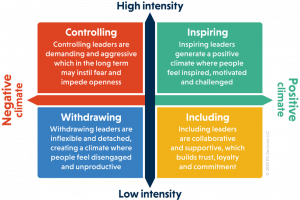Written by Dr. Jo Maddocks, Chief Psychologist
Previously published by PSI Talent Management or Cubiks, prior to becoming Talogy.
In many countries people are being encouraged to return to the workplace. For some it may be a joy and relief to be away from home and working with colleagues again. For others the transition back to the office environment may provoke fear and anxiety. According to a recent survey by McKinsey, almost half of those who have not yet returned to work expect a negative impact on their mental health, and about one third of those who have already returned have experienced negative mental health. One of the recommendations in the report was for organizations to support employees to build a ‘resilient mindset.’
In my previous blogs on coping with adversity during the pandemic, I focused on how employees can become more resilient. The other side to this coin is how organizations, and leaders in particular, can create a more supportive work environment where individuals feel they can thrive rather than just survive. In order to create a positive work climate, leaders may want to start by considering the following three questions:
- How do my colleagues feel working with me?
- What emotional climate do I create around me?
- What could I do to create a more positive work climate?
To help explore these questions, it is useful to apply the emotions wheel which was described more fully in my previous blog.

The emotions wheel shows four emotion zones (Stress, Burnout, Renew, and Energized). It is likely that all individuals will spend time in each of these zones at different times. As a leader, reflect on the next set of questions in relation to these four broad emotional areas.
- How many of your colleagues currently fall into each of the four emotion zones?
- What do you do as a leader that may cause your colleagues to fall into each of these four zones?
- How could you help colleagues to spend less time in Stress and Burnout?
- How could you help colleagues to spend more time in Renew and Energized?
One way to address these questions is to consider what leadership behaviors will facilitate a positive work climate and what leadership behaviors are likely to fuel a negative climate. Incidentally, negative leadership behaviors have been shown to have far greater impact on employee engagement than positive leadership behaviors, which is one reason why emotional intelligence is so important for effective leadership. PSI has mapped four leadership styles to each of the four emotion zones as shown here. For example, leaders who demonstrate Inspiring leadership behaviors are likely to create a work climate where people feel energized, while leaders who demonstrate Controlling behaviors are likely to create a more stressful work environment.

The aim for leaders is to spend more time in the Inspiring and Including zones and less time in the Controlling and Withdrawing zones. Here are four suggestions with corresponding tips for leaders on how to do this and create a more positive, thriving, and resilient organizational climate for all employees.
Inspiring
Show belief in others: Think of one person in your life who has a had a positive influence upon you. Perhaps they have inspired you, helped you through times of adversity, or simply built up your self-confidence. They may be a relative, a colleague, a teacher, or even an idol you have never met before. Then consider what it was about this person that had a positive impact on your life. Very often the answer people give is “they believed in me more than I believed in myself.” Pause for reflection, then extend this exercise to think about one person who you have influenced positively in your life and what it was about you that had a positive impact on that person.
Tip: Find an opportunity every day to show your appreciation towards a colleague.
Controlling
Be authentic: People tend to perform at their best when they feel psychologically safe (i.e., they feel they can be themselves and express their thoughts, feelings, and behaviors openly without fear of reprisal). Leaders who are open, genuine, and sincere are more likely to create such an environment. One reason for this is that the emotional part of the brain likes predictability where any risk or threat can be anticipated. Leaders who are unpredictable and unknown are likely to be perceived as a potential threat which puts people on guard and blocks openness. Authentic leadership begins with knowing yourself, your values, and your principles, and then acting accordingly.
Tip: Risk being more open than you usually are. Share something about yourself and express your feelings.
Withdrawing
Be a positive role model: There is a tendency in difficult times for people to share their negative stories as a way of consoling one another. The risk here is that they create a climate of helplessness and low morale where people only focus on their problems and concerns. As a leader it is important to provide a positive alternative. This doesn’t mean ignoring real challenges, but it does mean making people aware of opportunities, using constructive language, and sharing a clear vision. After all, if leaders don’t demonstrate this, why would others.
Tip: When you have a negative thought or hear a critical comment, counter this with two positives.
Including
Show compassion: In a Gallup survey completed by 2.7 million workers worldwide, one of the questions that stood out as being highly predictive of employee engagement, loyalty, and performance was that employees felt their manager cared about them. An important element of feeling cared for is being listened to. Most communication with others is in the form of a conversation – i.e., we exchange and share what is on our mind. Deeper or compassionate listening is when we focus entirely on the other person, suspend inner judgment, and remain curious to learn more about their thoughts, feelings, and needs. These are all important factors toward creating a psychologically safe environment.
Tip: Dedicate 10 minutes every day to listen to one of your colleagues. Ask questions and don’t interrupt!
These suggestions are not only about effective leadership behaviors but also represent underlying mindsets or intentions. For example, demonstrating effective listening skills does not necessarily mean you have genuine empathy and compassion toward others. For this to be authentic it is necessary to check within yourself how you feel: do you really care about others? Do you honestly want to know how they feel? If the answer to these is “no,” then it may be time to reflect on your intentions as a leader. If the answer to these is “yes,” then you are in a good place to start influencing others and the emotional climate around you.


